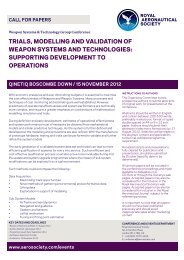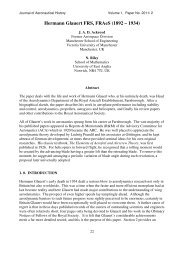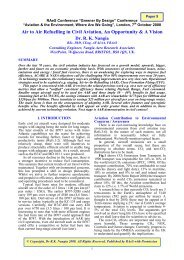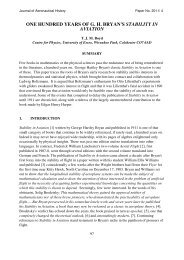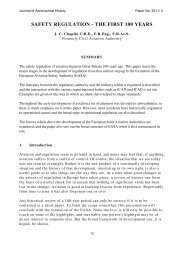The human element in airline training - Royal Aeronautical Society
The human element in airline training - Royal Aeronautical Society
The human element in airline training - Royal Aeronautical Society
Create successful ePaper yourself
Turn your PDF publications into a flip-book with our unique Google optimized e-Paper software.
26<br />
<strong>The</strong> <strong>human</strong> <strong>element</strong> <strong>in</strong> airl<strong>in</strong>e tra<strong>in</strong><strong>in</strong>g<br />
Appendix B<br />
what to th<strong>in</strong>k. <strong>The</strong>re are rare occasions when a sharp ‘kick up the<br />
backside’ delivered by the right person at the right time has the<br />
desired effect, but <strong>in</strong> general, tell<strong>in</strong>g people to change their<br />
attitude is not usually effective. This is particularly so if the person<br />
do<strong>in</strong>g the tell<strong>in</strong>g does not have the respect of the recipient, or<br />
represents an authority that lacks credibility. Ironically, this is also<br />
consistent with the <strong>in</strong>struction of positive behaviour, such as<br />
‘keep up the good work’ which has been known to produce an<br />
adverse reaction.<br />
<strong>The</strong> reason for this is that a person’s behaviour is based on past<br />
experiences, values and beliefs which will be different from those<br />
of others. <strong>The</strong>refore, tell<strong>in</strong>g people to behave differently carries<br />
the implication that their values and beliefs are wrong, and this is<br />
not conv<strong>in</strong>c<strong>in</strong>g. People generally behave <strong>in</strong> a way that they th<strong>in</strong>k<br />
is rational, and often f<strong>in</strong>d it easy to justify their behaviour to<br />
themselves and others. However, what they may not be aware of<br />
is the effects of their behaviour on other people or the operation;<br />
and that an alternative behaviour, which does not question their<br />
values but has a more positive effect, may be someth<strong>in</strong>g they<br />
might wish to consider.<br />
<strong>The</strong> technique of facilitation allows this process to occur,<br />
although it is not just for the poor performer nor for the<br />
development of attitudes. Facilitation can be equally used to<br />
re<strong>in</strong>force effective behaviour because it gives people an<br />
understand<strong>in</strong>g of why they are good which encourages their<br />
cont<strong>in</strong>ued development. Furthermore it can be used <strong>in</strong> the<br />
development of skills and even knowledge, because it is an<br />
effective tool for allow<strong>in</strong>g self-analysis and <strong>in</strong> depth thought,<br />
which is an easier way for people to learn, as there is less recourse<br />
to memory techniques. <strong>The</strong> skills of self-analysis are not just to get<br />
the most from the tra<strong>in</strong><strong>in</strong>g session, but can also be cont<strong>in</strong>ually<br />
used for self-development on the l<strong>in</strong>e.<br />
Table 1. Differences between <strong>in</strong>struction and facilitation<br />
INSTRUCTING FACILITATING<br />
1. What do the words imply? Tell<strong>in</strong>g, show<strong>in</strong>g Mak<strong>in</strong>g easy,<br />
enabl<strong>in</strong>g<br />
2. What is the aim? Transfer Ga<strong>in</strong> <strong>in</strong>sight/selfknowledge<br />
and analysis to<br />
develop skills enable an<br />
attitude change<br />
3. Who knows the subject? Instructor Both<br />
4. Who has the experience Instructor Both<br />
5. What is the relationship? Top down Equal<br />
6. Who sets the agenda Instructor Both<br />
7. Who talks the most? Instructor Student<br />
8. What is the timescale? F<strong>in</strong>ite Inf<strong>in</strong>ite<br />
9. Where is the focus? Instructor/task Student/attitudes<br />
/behaviour<br />
10. What is the workload? Medium/high Intense<br />
11. What are tra<strong>in</strong>ers Judgemental Non-judgemental<br />
thoughts?<br />
12. How is progress evaluated? Test<br />
Observation/Self-assessment<br />
Dr Guy Smith, NWA<br />
Notes on Table 1<br />
1. Although <strong>in</strong>structors have used facilitation techniques<br />
naturally for many years; <strong>in</strong> its purest sense <strong>in</strong>struct<strong>in</strong>g has a<br />
lot to do with tell<strong>in</strong>g, demonstrat<strong>in</strong>g and check<strong>in</strong>g that the<br />
task is be<strong>in</strong>g done <strong>in</strong> accordance with a standard. Whereas<br />
facilitation means that students are given the opportunity to<br />
discover what they are do<strong>in</strong>g and the effect it has on others<br />
and the task, so that they can make the decision themselves to<br />
alter their behaviour or even re<strong>in</strong>force any positive behaviour.<br />
This process should be made as easy as possible.<br />
2. <strong>The</strong> pr<strong>in</strong>ciple purpose of <strong>in</strong>struct<strong>in</strong>g is to transfer knowledge<br />
and skills efficiently, whereas with facilitation the pr<strong>in</strong>ciple<br />
purpose is to encourage a change <strong>in</strong> attitude or behaviour by<br />
the student ga<strong>in</strong><strong>in</strong>g <strong>in</strong>sight or becom<strong>in</strong>g aware of what they<br />
are do<strong>in</strong>g, and be<strong>in</strong>g motivated to change. People tend to<br />
only do th<strong>in</strong>gs that they want to do; so tell<strong>in</strong>g people that<br />
they are wrong and need to change is rarely effective. People<br />
generally do not behave <strong>in</strong> a way that they th<strong>in</strong>k is wrong.<br />
<strong>The</strong>y are aware that others might disapprove, but they will<br />
rationalise their behaviour as be<strong>in</strong>g appropriate under the<br />
circumstances. Tell<strong>in</strong>g them that you th<strong>in</strong>k they are wrong<br />
gives them no new <strong>in</strong>formation and often motivates them to<br />
cont<strong>in</strong>ue their current behaviour. <strong>The</strong> key is for them to<br />
understand why others disapprove and the consequences of<br />
cont<strong>in</strong>u<strong>in</strong>g as they are.<br />
3 & 4. When <strong>in</strong>struct<strong>in</strong>g, the tra<strong>in</strong>er knows the subject and has<br />
the experience, otherwise it would be a po<strong>in</strong>tless exercise.<br />
When facilitat<strong>in</strong>g both parties know the subject and have<br />
the experience, particularly when discuss<strong>in</strong>g behaviour. In<br />
fact, very competent facilitators are quite capable of be<strong>in</strong>g<br />
effective without know<strong>in</strong>g the subject or hav<strong>in</strong>g any<br />
experience of it. In many respects this can be a useful<br />
po<strong>in</strong>ter to know when to change hats from be<strong>in</strong>g an<br />
<strong>in</strong>structor to a facilitator. If you are certa<strong>in</strong> that only you<br />
have the relevant knowledge, and the student would f<strong>in</strong>d<br />
it difficult to work it out for themselves <strong>in</strong> the time<br />
available, then <strong>in</strong>struct<strong>in</strong>g is probably the most appropriate<br />
technique to employ.<br />
5. <strong>The</strong> relationship when <strong>in</strong>struct<strong>in</strong>g can be perceived as be<strong>in</strong>g<br />
top down <strong>in</strong> that the <strong>in</strong>structor knows more than the student,<br />
whereas when facilitat<strong>in</strong>g it must be apparently equal. A<br />
common mistake by <strong>in</strong>experienced tra<strong>in</strong>ers when facilitat<strong>in</strong>g<br />
is to create the impression that they are <strong>in</strong> some way superior,<br />
by imply<strong>in</strong>g they know more or have a better attitude.<br />
6. <strong>The</strong> agenda when facilitat<strong>in</strong>g must be set by both parties if<br />
the process of buy-<strong>in</strong> is to get the right start. Agree<strong>in</strong>g what<br />
you are go<strong>in</strong>g to talk about and how you will go about it is an<br />
important first step. A tra<strong>in</strong>er can greatly assist the learn<strong>in</strong>g of<br />
the session by summaris<strong>in</strong>g and giv<strong>in</strong>g mean<strong>in</strong>g to the<br />
students' discussions. It is still the <strong>in</strong>structor's responsibility to<br />
ensure that all the tra<strong>in</strong><strong>in</strong>g requirements are <strong>in</strong>cluded <strong>in</strong> the<br />
facilitative session.<br />
7. One of the best measures of identify<strong>in</strong>g which technique you<br />
are us<strong>in</strong>g, whether it is <strong>in</strong>struct<strong>in</strong>g or facilitat<strong>in</strong>g, is to note<br />
who is do<strong>in</strong>g most of the talk<strong>in</strong>g. When facilitat<strong>in</strong>g students<br />
need to be clear <strong>in</strong> their own m<strong>in</strong>ds and be able to self assess<br />
what they are do<strong>in</strong>g and the benefits of chang<strong>in</strong>g, it is<br />
difficult to do this while try<strong>in</strong>g to listen to a tra<strong>in</strong>er pass<strong>in</strong>g<br />
multiple messages.<br />
8. <strong>The</strong> time taken to cover a subject when <strong>in</strong>struct<strong>in</strong>g tends to be<br />
f<strong>in</strong>ite and consistent; whereas with facilitation the timescale is<br />
<strong>in</strong>def<strong>in</strong>ite. This does not mean that it takes forever, but that<br />
the process of facilitation must be given sufficient time to<br />
achieve its aim. <strong>The</strong> CRMI should not be worried about longer<br />
debrief or exercise times, because the student’s concentration<br />
period is much longer when they are actively <strong>in</strong>volved <strong>in</strong> the<br />
th<strong>in</strong>k<strong>in</strong>g and discussion rather than passively listen<strong>in</strong>g. In a<br />
limited time period, such as a debrief, the process may need to<br />
cont<strong>in</strong>ue afterwards, while students try out new options back<br />
at work. Conversely, if the aim is achieved <strong>in</strong> a few m<strong>in</strong>utes,<br />
the job is done and there is no po<strong>in</strong>t dragg<strong>in</strong>g out the<br />
discussion.




